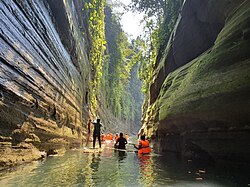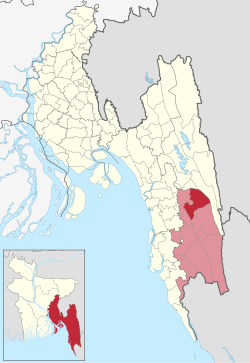Rowangchhari
রোয়াংছড়ি | |
|---|---|
 Debotakhum | |
 | |
| Coordinates: 22°10′N 92°20′E / 22.167°N 92.333°E | |
| Country | |
| Division | Chittagong |
| District | Bandarban |
| Government | |
| • Upazila Chairman | Chohaimong Marma |
| • MP (Bandarban) | Ushwe Sing |
| Area | |
• Total | 442.88 km2 (171.00 sq mi) |
| Population | |
• Total | 27,721 |
| • Density | 63/km2 (160/sq mi) |
| Time zone | UTC+6 (BST) |
| Postal code | 4610[2] |
| Website | rowangchhari |
Rowangchhari (Bengali: রোয়াংছড়ি) is an upazila (sub-district) of Bandarban District in southeastern Bangladesh, part of the Chittagong Division.[3]
History

In the 16th century, the Marma people emigrated here from the Kingdom of Mrauk U in Arakan. Where the Rakhaing stream (known as a chhara in Bengali) meets the Tarachha canal, the Marmas established a settlement known as Rakhaing Wah, meaning the "Rakhaing river mouth". Bengalis from the nearby Chittagong District later arrived in the area for trade and commercial purposes. Over time, Rakhaing Wah grew into a haat bazaar and became known to Bengalis as Rowangchhari (Rowang is the Chittagonian word for Arakan and chhari refers to a small stream).[4]
During the Bangladesh Liberation War of 1971, a brawl took place in Nowapatang Union leading to the death of T. N. Ali, a Bengali freedom fighter. Shamsul Islam ibn Amir Hamzah of Main Road and Dr S. A. Mahiuddin ibn Muhammad Abdur Rashid of Rowangchhari Bazar also fought in the war. There are also seven other individuals from Rowangchhari not mentioned in the official gazette that are said to have taken part. These are: Tarachha's Muhammad Ibrahim ibn Jalal Ahmad, Foraq Ahmad ibn Kala Mia, Qazi Muhammad Thanaullah ibn Qazi Ahmad Safa, Liaqat Ali ibn Faiz Ahmad and Muhammad Abdul Wadud ibn Siraj Ahmad, Rowangchhari Bazar's Abul Hasan Mir ibn Habibullah Mir, Abdul Aziz Chowdhury ibn Ashab Mia Chowdhury and Ejahan Mia ibn Dudu Mia.[5]
In 1976, Rowangchhari was established as a thana. Its status was upgraded to upazila (sub-district) in 1983 as part of the President of Bangladesh Hussain Muhammad Ershad's decentralisation programme.[4]
Geography
Rowangchhari is located at 22°10′00″N 92°20′00″E / 22.1667°N 92.3333°E. It has a total area of 442.88 km2.
Demographics
As of the 2022 Bangladeshi census, Rowangchhari upazila had a population of 27,721. The ethnic population was 24,808 (89.49%), of which Marma were 13,716,Tanchangya 3,990, Tripura 2,143, Bom 1,882 and Mru 1,685.[6]
Rowangchhari is an ethnically diverse sub-district of Bangladesh. It is home to the Marma people who speak Arakanese, the Bawm who speak Bawm, the Tanchangya who speak Tanchangya, the Mru who speak Mru, the Khumi who speak Khumi Chin, the Khyang who speak Shö and the Bengalis who speak the Chittagonian dialect of Bengali.[7]
Administration
Rowangchhari Upazila is divided into four union parishads: Alikhong, Nowapatang, Rowangchhari, and Tarachha. The union parishads are subdivided into 13 mauzas and 178 villages.[9]
| Name | Date | Notes |
|---|---|---|
| Kya Shai Aung | 25/5/1985 | |
| Hla Thowai Hri Marma | 23/2/2009-16/4/2014 | |
| Kyaba Maung Marma | 17/4/2014 | |
| Mausang Marma | 30/3/2017-24/4/2019 | Panel chairman, first female |
| Chohaimong Marma | 9/5/2019-present |
Facilities
There are 43 churches, 41 Buddhist temples, 5 Hindu temples and 12 mosques in Rowangchhari. There are two madrasas in Rowangchhari; the North Chhaingya Nurani Madrasa and the West Chhaingya Nurani Madrasa. The mosques are:[10]
- Rowangchhari Jame Mosque, Rowangchhari Bazar
- Rowangchhari Wagaipar Jame Mosque
- North Chhaingya Jame Mosque
- South Chhaingya Jame Mosque
- Middle Chhaingya Jame Mosque
- East Chhaingya Jame Mosque
- Gherau Bazar Jame Mosque
- Betchhara Bazar Jame Mosque
- Tarachha Mukh Jame Mosque
- Muramnango Police Camp Jame Mosque
- Banchhaya Jame Mosque, Alekkhang Union
- Kachhaptali Para Army Camp Jame Mosque, Alekkhang Union
See also
References
- ^ National Report (PDF). Population and Housing Census 2022. Vol. 1. Dhaka: Bangladesh Bureau of Statistics. November 2023. p. 396. ISBN 978-9844752016.
- ^ "Bangladesh Postal Code". Dhaka: Bangladesh Postal Department under the Department of Posts and Telecommunications of the Ministry of Posts, Telecommunications and Information Technology of the People's Republic of Bangladesh. 20 October 2024.
- ^ Atikur Rahman (2012). "Rowangchhari Upazila". In Sirajul Islam; Miah, Sajahan; Khanam, Mahfuza; Ahmed, Sabbir (eds.). Banglapedia: the National Encyclopedia of Bangladesh (Online ed.). Dhaka, Bangladesh: Banglapedia Trust, Asiatic Society of Bangladesh. ISBN 984-32-0576-6. OCLC 52727562. OL 30677644M. Retrieved 19 November 2024.
- ^ a b রোয়াংছড়ি উপজেলার পটভূমি [Background of Rowangchhari Subdistrict]. Rowangchhari Upazila (in Bengali).
- ^ মুক্তিযুদ্ধে রোয়াংছড়ি [Rohangsari in the Liberation War]. Rowangchhari Upazile (in Bengali).
- ^ a b c Population and Housing Census 2022 - District Report: Bandarban (PDF). District Series. Dhaka: Bangladesh Bureau of Statistics. June 2024. ISBN 978-984-475-276-4.
- ^ ভাষা ও সংস্কৃতি [Language and culture]. rowangchhari Upazila (in Bengali).
- ^ https://bbs.gov.bd/site/page/2888a55d-d686-4736-bad0-54b70462afda/-
- ^ "Bangladesh Population and Housing Census 2011 Zila Report – Bandarban" (PDF). bbs.gov.bd. Bangladesh Bureau of Statistics.
- ^ মসজিদ [Mosque]. Rowangchhari Upazila (in Bengali).









